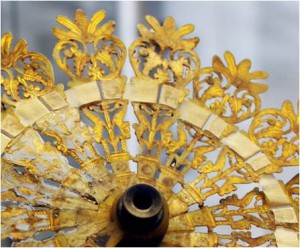 Fans are so much more than fashionable accessories: They are useful for flirting, can cool heated cheeks or hide an unladylike emotion. In the wake of the Napoleonic War, their usefulness was boosted beyond the known limit when fans were made for spying, i.e. discretely observing the surrounding or other persons. I found some examples of these extraordinary devices when I visited the exhibition “Waterloo: Life & Times” of the Fan Museum in Greenwich, UK.
Fans are so much more than fashionable accessories: They are useful for flirting, can cool heated cheeks or hide an unladylike emotion. In the wake of the Napoleonic War, their usefulness was boosted beyond the known limit when fans were made for spying, i.e. discretely observing the surrounding or other persons. I found some examples of these extraordinary devices when I visited the exhibition “Waterloo: Life & Times” of the Fan Museum in Greenwich, UK.
Results for Tag: Science
Forecasting the Weather in the 18th Century

Will there be rain, sun or snow within the next days? Should I plant my crops – or rather delay a journey? Predicting the weather was an art by itself in the 18th century. A scientific approach to weather forecasting started in earnest from the early 18th century, but progress was slow. So how did people like Jane Austen forecast the weather?
Continue readingShades of Blue: Discovering new colours in the 18th Century
 The 18th century sees an increase in scientific knowledge and practical research. Many findings have a direct impact on everyday life, craft and commerce. New technics allows, e.g., to create new colours. Find out here what Napoleon’s Campaign in Egypt, the Prussians and an apothecary have to do with the various blue pigments created in the long 18th century.
The 18th century sees an increase in scientific knowledge and practical research. Many findings have a direct impact on everyday life, craft and commerce. New technics allows, e.g., to create new colours. Find out here what Napoleon’s Campaign in Egypt, the Prussians and an apothecary have to do with the various blue pigments created in the long 18th century.
Tartan! Steam! Photography! 1822 brings about change
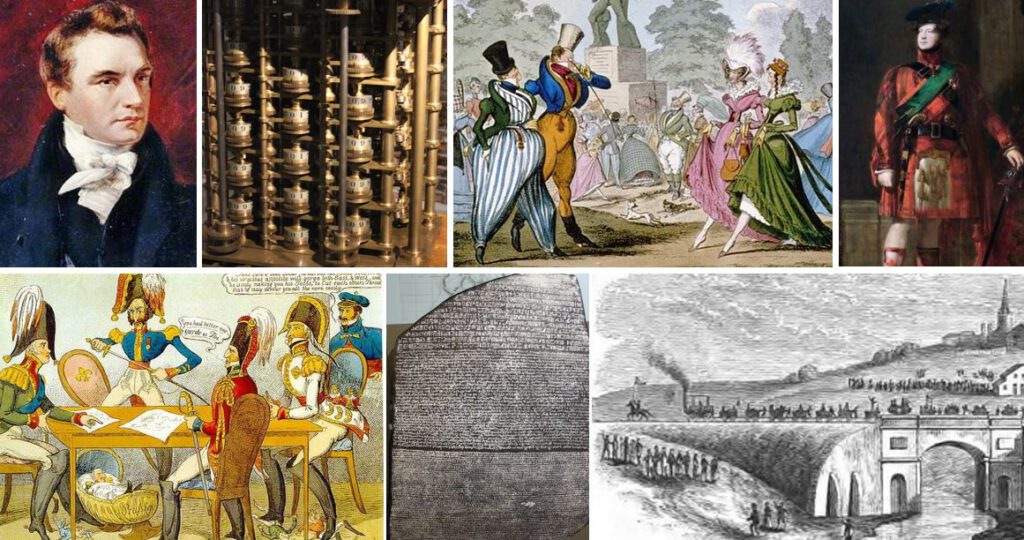 In 1822, Britain leaves the recession of the post-war period. The Napoleonic Wars had cost the nation an estimated £83 billion in modern terms – it is the most expensive war so far. The country’s debt is almost 200% of its GDP in 1822; this, however, is already better than in 1819, when the debt peaked at around 260 percent of the GDP.
In 1822, Britain leaves the recession of the post-war period. The Napoleonic Wars had cost the nation an estimated £83 billion in modern terms – it is the most expensive war so far. The country’s debt is almost 200% of its GDP in 1822; this, however, is already better than in 1819, when the debt peaked at around 260 percent of the GDP.
Government deficits are financed either by short‐term Exchequer Bills, or by long‐term financing as perpetual bonds, with annual interest rates about 5, respectively 3, percent. This system of financing brings important benefits: With the return of peace, their prices would rise, adding to the bondholders’ wealth in this way. This money then provides much of the finance underpinning for the “take‐off ”-stage of the Industrial Revolution.
Economic grows begins to pick up pace. The general price level falls. Additionally, reforms for free trade start. Britain sees some prosperity.
Find out more about innovations, fashion, celebrities, and social news of this exiting year in England. Continue reading
The Poor Man’s Son Who Usurped the British Market of Optical Lenses
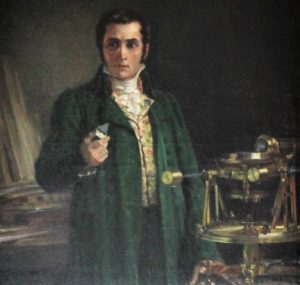 Since the mid-18th century, England had been the centre of the optics industry, due to the work of instrument-maker John Dolland (1706-1761). Dolland manufactured small ‘achromatic’ telescopes with high-quality lenses made of flint glass (instead of the inferior crown glass). His products were in high demand from astronomers all over Europe. This began to change, when a poor man’s son, who had had a lot of bad luck in his youth, met the Bavarian Prince Elector. Continue reading
Since the mid-18th century, England had been the centre of the optics industry, due to the work of instrument-maker John Dolland (1706-1761). Dolland manufactured small ‘achromatic’ telescopes with high-quality lenses made of flint glass (instead of the inferior crown glass). His products were in high demand from astronomers all over Europe. This began to change, when a poor man’s son, who had had a lot of bad luck in his youth, met the Bavarian Prince Elector. Continue reading
The Origin of Now, Part 4
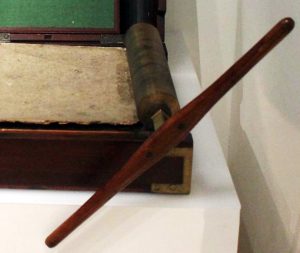 About 250 years ago, science spread into the world and everyday life. People asked how scientific progress and inventions could make life better and easier. They set out to develop and pursue new ideas. Some of these are still around today. In the fourth part of my series, we discover how the invention of a Scottish mechanical engineer changed the office world forever.
About 250 years ago, science spread into the world and everyday life. People asked how scientific progress and inventions could make life better and easier. They set out to develop and pursue new ideas. Some of these are still around today. In the fourth part of my series, we discover how the invention of a Scottish mechanical engineer changed the office world forever.
The Letter Copying Press and Mr Watt’s Secrets Recipes for Ink and Liquor
The Origin of Now (Part 3)
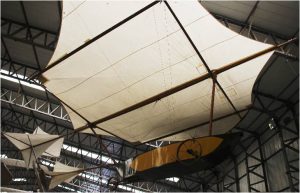 This series is dedicated to inventions, ideas and concepts developed during the Romantic Age that shaped our modern world. With the second scientific revolution, a series of breakthroughs in science led to the idea that scientific progress could make life better and easier. Inventive individuals set out to pursue new ideas (also see part 1 and part 2 of this series). One of them was Sir George Cayley (1773-1857). Follow me back to the 1790ies to find out how his dream of flying laid the foundation of today’s aviation.
This series is dedicated to inventions, ideas and concepts developed during the Romantic Age that shaped our modern world. With the second scientific revolution, a series of breakthroughs in science led to the idea that scientific progress could make life better and easier. Inventive individuals set out to pursue new ideas (also see part 1 and part 2 of this series). One of them was Sir George Cayley (1773-1857). Follow me back to the 1790ies to find out how his dream of flying laid the foundation of today’s aviation.
The Man Who Understood Why Airplanes Fly
Sir George Cayley sketched his first flying machine aged 19, in 1792. Continue reading
The Origin of Now: Part 2
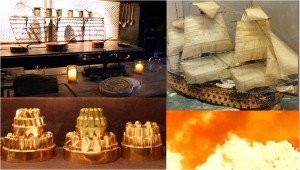 Our modern world was born in the 18th century. Numerous inventions, ideas and concepts developed during the Romantic Age can still be found in our everyday life. In the previous part of this series I had presented roller skates, the steel pen and the financial instrument ‘pfandbrief’ as brainchildren of the 18th century. Today, we discover how a chef and a baronet shaped our world. Continue reading
Our modern world was born in the 18th century. Numerous inventions, ideas and concepts developed during the Romantic Age can still be found in our everyday life. In the previous part of this series I had presented roller skates, the steel pen and the financial instrument ‘pfandbrief’ as brainchildren of the 18th century. Today, we discover how a chef and a baronet shaped our world. Continue reading
Captain Stanhope’s Invention: A Carriage for ‘The Ton’
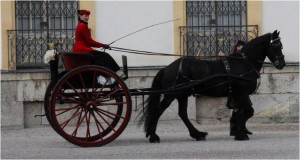 At a historical hunting and carriage show, a vehicle caught my eye: It featured a high seat for two persons, large wheels and shafts with an upward reverse curve. There was an air of elegance and sportiness about it, and it was driven by a lady.
At a historical hunting and carriage show, a vehicle caught my eye: It featured a high seat for two persons, large wheels and shafts with an upward reverse curve. There was an air of elegance and sportiness about it, and it was driven by a lady.
I had to check it out. Continue reading
The Girl, the Kite and the Eccentric Inventor
In this post:
Inventions and science in the Romantic Age
Help, my father is an inventor!
Martha Pocock as a character of a novel – and plot bunnies involving the Pocock family
Martha Pocock was not what we associate with a typical girl of the Romantic Age. She was neither an epitome of propriety nor a simpering Miss. Martha had guts and she was hands-on. She was the first woman to be lifted into the air under a kite. Martha owed her experiences in flying under a kite to her father. George Pocock (1774–1843) was an inventor and a schoolmaster. He became famous for inventing the first kite-drawn carriage. Sounds like a joke? It’s not.
